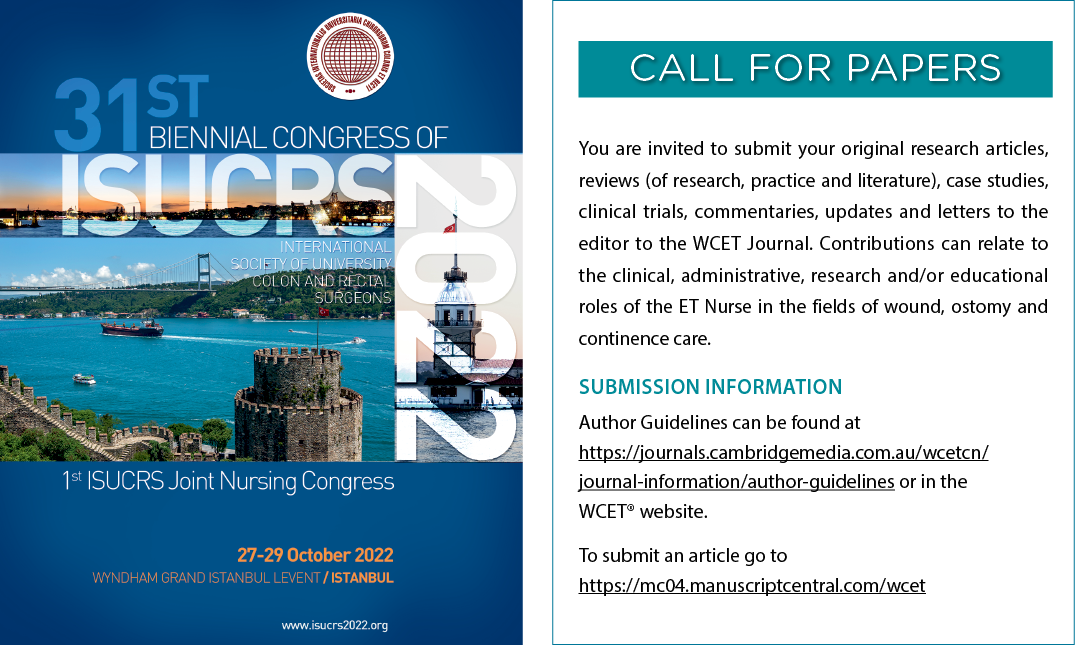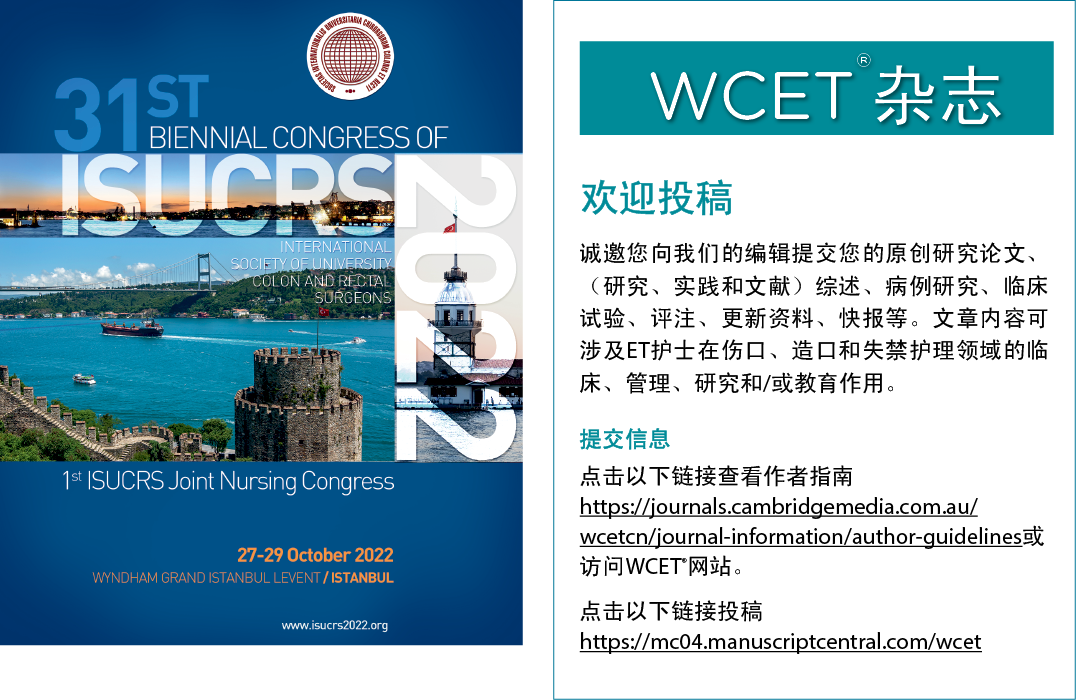Volume 42 Number 1
Recognition
Jenny Prentice
For referencing Prentice J. Recognition. WCET® Journal 2022;42(1):7-8
DOI https://doi.org/10.33235/wcet.42.1.7-8
Recognising achievement is a wonderful way to commence Volume 42 of the WCET® Journal.
Life Achievement Awards were bestowed on three widely known members of the WCET® fraternity in recognition of their global contribution to wound management by the World Union of Wound Healing Societies in March 2022. We are delighted that each recipient of this award, Dr Elizabeth A Ayello (USA), Professor Keryln Carville (Australia) and Professor R Gary Sibbald (Canada) , have generously agreed to further share their knowledge and skill by featuring an aspect of their work within the WCET® Journal during 2022. On behalf of the Editorial Board may I extend our congratulations to Elizabeth, Keryln and Gary and all other recipients of the Life Achievement Award.
Professor Sibbald’s contribution is featured in this edition and focusses on defining the ten statements embedded within a further revision of the universally accepted wound bed preparation paradigm. Healable, non-healable and maintenance wounds are discussed within the parameters of ten statements that include: patient centred concerns; determining ability to heal; local wound care; debridement; management of infection, inflammation, moisture and edge effect. Evaluation of wound healing and the importance of organisational support are also addressed.
When considering any research or project including ostomy, wound or continence care it is important to recognise the methods used to undertake the study or project will have an impact on results obtained. Therefore, it is imperative consideration be given to numerous factors prior to the commencement of a study or project such as purpose, design and questions to be asked and answered and data analysis. We are fortunate to be able to build on previous processes highlighted in the journal in terms of synthesising evidence by1,2 having a series of articles in this and forthcoming issues by Dr John Stephenson on salient principles to be aware of when embarking on research studies or projects.
Dr John Stephenson is a Senior Lecturer in Biomedical Statistics at the University of Huddersfield, United Kingdom and Adjunct Associate Professor at Swinburne University of Technology, Melbourne, Australia. In addition to working with clinical colleagues across a range of clinical disciplines, including primary care; wound care/tissue viability; dermatitis; spinal surgery; surgical site infections; podiatric and lower limb studies and cancer, John also has extensive experience as a biomedical statistician in academia. He advises on research study design and applies advanced statistical methodologies in clinical research contexts. Methods include (amongst others): multilevel modelling, time-to-event/multistate & competing risk modelling, generalised linear modelling, multivariate methods, structural equation modelling and meta-analysis methods.
Within his first article here Dr Stephenson discusses the purpose and benefits of commonly used types of experimental and non-experimental study designs. Design issues, variables and units of analysis are also addressed. Each design concept is well illustrated with a clinical example in wound management.
The ability to recognise and manage unusual and complex wounds is paramount to patient care. Zhang et al describe the presentation of a patient with suspected hand foot syndrome (HFS) resulting from detrimental side effects of Xeloda, an anti-tumour drug. This debilitating condition can result in extensive tissue destruction and impair quality of life especially in the aged. Differences between HFS and hand-foot skin reaction due to the use of multikinase or BRAF Inhibitors and case resolution using a multidisciplinary team approach are described.
It is well recognised that middle to low-income countries are often poorly resourced in terms of health delivery inclusive of wound management services and products. Traditionally, locally available biomaterials have often been used as the basis for topical dressing products. Solomons and Haesler explore current available evidence around the clinical use of papaya for managing and promoting wound healing within the WHAM evidence summary.
Expansion of our Editorial Board continues. It is my pleasure to welcome Professor Al-Sanea to the WCET® Board. Professor Al-Sanea is the Head of Section, Colon & Rectal Surgery King Faisal Specialist Hospital and Research Centre, Saudi Arabia. He is the current Editor-in-Chief, Annals of Saudi Medicine thereby bringing a wealth of experience to the WCET® Board.
The forthcoming joint Congress WOCNext® 2022 hosted by WCET® and the WOCN® recognises and celebrates the importance of ongoing education in this specialist field of nursing. I wish the organisers and all attendees a very successful Congress.
With Kind Regards
Jenny

表彰
Jenny Prentice
DOI: https://doi.org/10.33235/wcet.42.1.7-8
表彰成就是开启WCET®杂志第42卷的绝佳方式。
2022年3月,世界伤口愈合学会联盟授予WCET®同仁中3名广为人知的成员生命成就奖,以表彰他们对伤口管理的全球贡献。很高兴看到该奖项的每一位获奖者,Elizabeth A Ayello博士(美国)、Keryln Carville教授(澳大利亚)和R Gary Sibbald教授(加拿大),都慷慨地同意2022年在WCET®杂志上介绍他们工作的一个方面,进一步分享他们的知识和技能。我谨代表编委会祝贺Elizabeth、Keryln和Gary以及生命成就奖的所有其他获奖者。
本版刊登了Sibbald教授的贡献,重点阐述了对普遍接受的创面床准备范式的进一步修订中所包含十项声明的定义。在十项声明的参数范围内对可愈合、不可愈合和维持性伤口进行了讨论,讨论内容包括:以患者为中心的问题;确定愈合能力;局部伤口护理;清创术;感染处理、炎症、水分和边缘效应。还讨论了伤口愈合评估和组织支持的重要性。
在考虑包括造口、伤口或失禁护理在内的任何研究或项目时,必须认识到进行研究或项目所用的方法将对获得的结果产生影响。因此,在开始一项研究或项目前,必须考虑诸多因素,如目的、设计、需要询问和回答的问题以及数据分析。我们很幸运,能够在本刊强调的先前流程的基础上,1,2通过John Stephenson博士在本期和下期发表一系列关于开展研究或项目时应注意的重要原则的文章来综合证据。
John Stephenson博士是英国哈德斯菲尔德大学生物医学统计学高级讲师,澳大利亚Melbourne斯威本科技大学兼职副教授。除了与一系列临床学科的同事合作外,包括初级护理、伤口护理/组织活力、皮炎、脊柱手术、手术部位感染、足科和下肢研究以及癌症,John在学术界也拥有丰富的生物医学统计学家经验。他为研究设计提供建议,并在临床研究环境中应用先进的统计方法。方法包括(除其他外):多级建模、事件发生时间/多态和竞争风险建模、广义线性建模、多元方法、结构方程建模和元分析方法。
在本刊的第一篇文章中,Stephenson博士讨论了常用的实验和非实验研究设计类型的目的和益处。还讨论了设计问题、变量和分析单位。每个设计概念都通过伤口管理临床示例得到了很好的说明。
识别和处理异常和复杂伤口的能力对于患者护理至关重要。Zhang等人描述了一例由抗肿瘤药物Xeloda的有害副作用引起的疑似手足综合征(HFS)患者的表现。这种衰弱性疾病会导致广泛的组织破坏,并损害生活质量,尤其是在老年人中。文中描述了由于使用多激酶或BRAF抑制剂导致的HFS和手足皮肤反应之间的差异,以及使用多学科团队方法解决的病例。
众所周知,中低收入国家在卫生服务(包括伤口管理服务和产品)方面往往资源匮乏。传统上,当地可用的生物材料经常被用作局部敷料产品的基础。Solomons和Haesler在WHAM证据总结中探讨了目前关于木瓜在临床上用于管理和促进伤口愈合的现有证据。
我们的编委会继续扩大。我很荣幸地欢迎Al-Sanea教授加入WCET®委员会。Al-Sanea教授是沙特阿拉伯费萨尔国王专科医院和研究中心结肠和直肠外科科长。他是现任《沙特医学年鉴》主编,因此为WCET®委员会带来了丰富的经验。
即将召开的由WCET® 和WOCN®主办的WOCNext® 2022联合大会认识到并庆祝在该护理专业领域持续教育的重要性。祝愿大会组织者和所有与会者取得圆满成功。
谨致问候
Jenny

Author(s)
Jenny Prentice
PhD, BN, RN, STN, FAWMA
References
- Prentice J. Synthesising evidence. WCET® Journal 2021;41(2):6. DOI https://doi.org/10.33235/wcet.41.2.6
- Prentice J. Synthesising evidence – part 2. WCET® Journal 2021;41(3):9-11. DOI https://doi.org/10.33235/wcet.41.3.9-11


